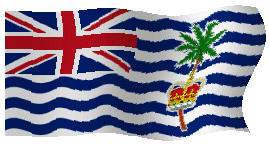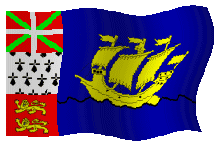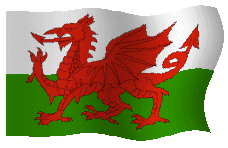
|
| Flagman's Vexi-Page: How to design personal flags and emblems. |
| Vexillology Without a doubt, this may be a strange word to you. What could this word possibly mean? Strictly speaking, vexillology is the study of the history, design, and usage of flags. Moreover, it also involves the study of symbols as they relate to the human experience. This would include "Heraldry" (the art and science of coats-of-arms), and other symbols such as seals, insignia, and logos. The primary objective of vexillology is to gather, disseminate, and interpret accurate information on flags and other symbols, how and why they came about, and how society relates to the usage of such symbols. Why are flags important? Flags have been around since the dawn of civilization in one form or another. Sculpture from such diverse places as ancient Egypt and Mexico indicate that flags played a role in the functioning of society. No one knows what the first vexilloid (flag-like object) was, but it may have been as simple as an animal skull, a dyed animal skin, or even a bunch of feathers held aloft on a stick. This simple emblem would have been enough to graphically unify a group of hunter-gatherers and possibly even bring fear into the hearts of their enemies! One of the first things to remember is that each symbol has no real meaning in and of itself. Individuals and societies assign a meaning to any given emblem. A fine example is the flag of the United States of America. In the most basic sense, it is simply a piece of cloth adorned with various colored elements, such as stripes and stars. To the collective mind of the population of this country, it is symbolic of the nation. It is also the "legal" emblem of the nation used by emisaries and the armed forces of this country to symbolize the power and prestige of the nation. It can also be called the "security blanket" of the nation. While the Constitution of the United States is what guarantees our freedoms and serves as the basis for the functioning of the nation, it is the sight of the flag gives the nation a sense of security, community, and continuity. In other parts of the world the same flag may serves as a beacon of hope to those that wish to escape oppression or poverty. People from far flung lands often have a US flag in their possession as a symbol that things can be better. People in the United States often publicly demonstrate their loyalty to the U.S.A. by flying the U.S. flag from a pole, hanging the flag on the wall, or using it as a window decoration. They also decorate a veriety of household objects with small flags, flag decals, or paint them with flag inspired motifs. Yet to others, the U.S. flag serves as the symbol of the oppressor. These people will often show their hatred of the United States and all that it stands for by publicly burning or trampling the flag. The flag can also be used to graphically demonstrate a political perspective of an individual by using the design in an artistic statement. For example, people opposed to the death penalty might remove the 50 stars on the flag and replace them with 50 skulls. Pro-marijuana protestors might replace the stars with marijauana leaves. Peace activists often remove the stars and replace it with a large peace sign. Human rigths activits have also turned the flag so that the stripes run vertically and placed a man behind the red stripes, making them appear to be the bars of a jail cell. In fact, any emblem, be it a red star, American eagle, cross, Star of David, crescent moon, or even a swastika, can have multiple meanings. Each meaning is dependent of the perspecitve of the viewer. For example, the eagle in various forms has been used throughout history by a number of cultures as the official symbol of the state. From the Roman Empire to the Russian Empire, the United States, Mexico, and Poland. Each entity using the same animal but rendering it differently to identify a specific political or national ideal. The eagle has no real meaning but we assign one to it, depending on where we live. Then there are grraphic symbols. A graphic symbol in and of itself has no real meaning. It is when we assign a meaning that we understand what someone is trying to say. For example, a hammer is just a hammer, but when it was combined with a sickle, it became the symbol of Communism. Despite it's long history as a symbol for the sun or luck, when Adolph Hitler adopted the swastika, it bcame the most reviled emblem in history. Colors have no real meaning, it all depends on how we view them. In an Islamic country, green in the flag would represent the faith of the people. That same color in the flags of Ireland, Mexico, Jamaica, and South Africa have different meanings altogether. Flags and other emblems can also be used by small groups such clubs, corporations, and families. Flags and other emblems can also be used by individuals. For example, the Queen of England uses a distinctive flag that only she can use. This is called a "personal flag". In addition she has other distinctive flags that she uses throughout the British Commonwealth of Nations. The flag for her use in Canada is different from the one for her use in Australia. She also uses an emblen known as a "cypher", which is basically her initials (in the case it is "EIIR" which means "Elizabeth Regina II"). The cypher can be used alone or even on a flag. The flag of the President of the United States differs in that it is a "positional flag". The flag of the President represents not the individual but the Office of the President. The flag of the President of France is somewhere in between the personal and positional. The French President uses the national flag with the addition of a personal symbol in the middle stripe. Now you too, can design and use your own personal or family flag. It's really quite easy to do once you learn how. ---------------------------------------------------------------------------- Personal flags are just a small part of the world of Vexillology. If you have more than just a passing interest in flags, you might want to visit the website of the North American Vexillological Association. Just click the link below. |
 |
 |
 |
 |
 |
| The Flag of N.A.V.A. |